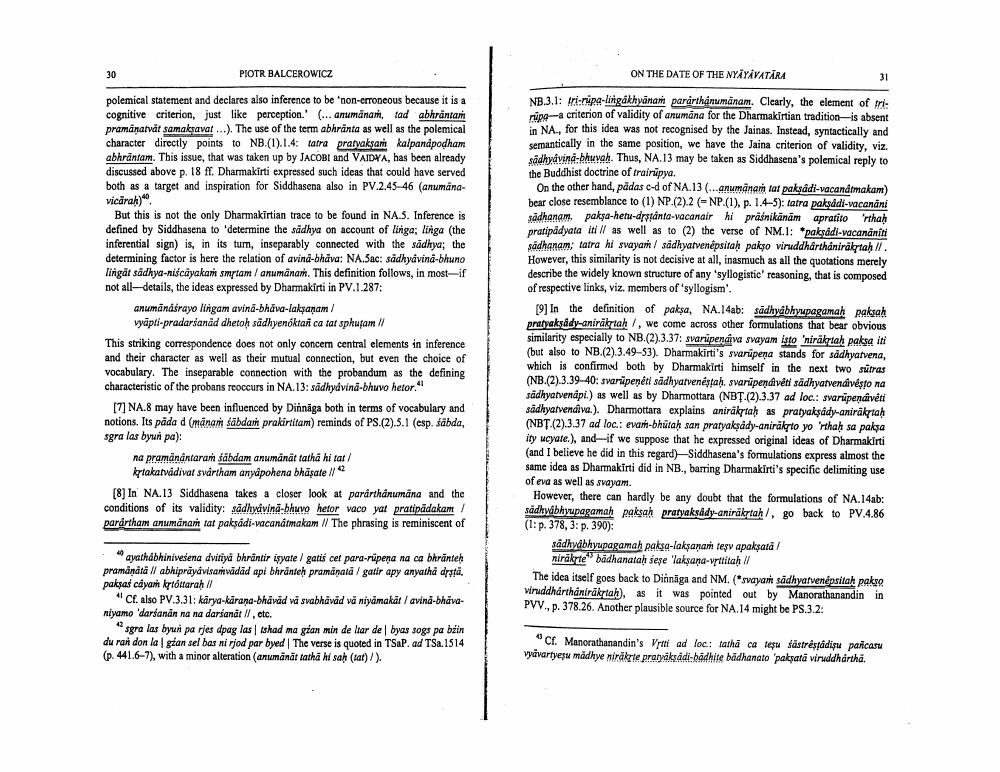Book Title: On The Date Of The Nnyayavatara Author(s): Piotr Balcerowicz Publisher: Piotr Balcerowicz View full book textPage 8
________________ PIOTR BALCEROWICZ ON THE DATE OF THE NYÄYAVATĀRA polemical statement and declares also inference to be 'non-erroneous because it is a cognitive criterion, just like perception.' (... anumana, tad abhräntar pramanatvat samaksavat...). The use of the term abhränta as well as the polemical character directly points to NB.(1).1.4: tatra pratyakşam kalpandpodham abhrāntam. This issue, that was taken up by JACOBI and VAIDYA, has been already discussed above p. 18 ff. Dharmakirti expressed such ideas that could have served both as a target and inspiration for Siddhasena also in PV.2.45-46 (anumanavicārah) But this is not the only Dharmakirtian trace to be found in NA.S. Inference is defined by Siddhasena to 'determine the sadhya on account of linga; linga (the inferential sign) is, in its tum, inseparably connected with the sadhya; the determining factor is here the relation of avind-bhava: NA.Sac: sadhyavina-bhuno Tirgår sådhya-niscayakan smrtam/ anumanam. This definition follows, in most-if not all-details, the ideas expressed by Dharmakirti in PV.1.287: anumanasrayo lingam avina-bhava-laksanam/ vyāpli-pradarsanad dhetoh sādhyenoktañ ca tat sprutam // This striking correspondence does not only concem central elements in inference and their character as well as their mutual connection, but even the choice of vocabulary. The inseparable connection with the probandum as the defining characteristic of the probans reoccurs in NA.13: sadhyavina-bhuvo hetor." [7]NA.8 may have been influenced by Dinnaga both in terms of vocabulary and notions. Its pada d (mānam sābdam prakirtitam) reminds of PS.(2).5.1 (esp. sābda, sgra las byun pa): na pramănântaram sābdam anumanät tatha hi tat/ krtakatvadivar svårtham anyápohena bhāşate // (8) In NA.13 Siddhasena takes a closer look at pararthanumana and the conditions of its validity: sadhyavina-bhuvo hetor vaco yat pratipādakam parartham anumanan tar paksadi-vacanátmakam // The phrasing is reminiscent of NB.3.1: tri-rupa-lingakhyānam pararthanumānam. Clearly, the element of trining criterion of validity of anumana for the Dharmakirtian tradition is absent in NA.. for this idea was not recognised by the Jainas. Instead, syntactically and semantically in the same position, we have the Jaina criterion of validity. viz. vidhyavina-bhuvah. Thus, NA. 13 may be taken as Siddhasena's polemical reply to the Buddhist doctrine of trairūpya. On the other hand, pädas c-d of NA.13(...anumanam tat pakşádi-vacandemakam) bear close resemblance to (1) NP.(2).2 (NP.(1), p. 1.4-5): tatra paksádi-vacanāni sādhanam paksa-hetu-drstânta-vacanair hi praśnikānām apratito 'rthah pratipadyata iti // as well as to (2) the verse of NM.I: *pakyddi-vacananiti sadhanam, tatra hi svayam/ sadhyatvenepsitah pakso viruddharthanirdytah II. However, this similarity is not decisive at all, inasmuch as all the quotations merely describe the widely known structure of any 'syllogistic' reasoning, that is composed of respective links, viz. members of syllogism'. 19 In the definition of paksa, NA.14ab: sadhyabhupagamah raksah pratyakyddy-anirakrtah/, we come across other formulations that bear obvious similarity especially to NB.(2).3.37: svarūpendiva svayam isto 'mirakrtah paksa in (but also to NB.(2).3.49-53). Dharmakirti's svarūpena stands for sådhyatvena, which is confirmed both by Dharmakirti himself in the next two sutras (NB.(2).3.39-40: svarüpenéti sadhyatvenéstah, svarūpendiveti sadhyatendivesto na sädhyatvendpi) as well as by Dharmottara (NBT.(2).3.37 ad loc.: svarüpendivél sådhyatvendiva). Dharmottara explains anirāktah as pratyakşády.anirāktah (NBT (2).3.37 ad loc.: evam-bhūtah san pratyaksády-anirakato yo 'ythah sa paksa ity wcyate.), and if we suppose that he expressed original ideas of Dharmakirti (and I believe he did in this regard) Siddhasena's formulations express almost the same idea as Dharmakirti did in NB., barring Dharmakirti's specific delimiting use of eva as well as svayam. However, there can hardly be any doubt that the formulations of NA.14ab: sådhvibhupagamah paksah pratyakşddy-aniräktah, go back to PV.4.86 (1: p. 378, 3. p. 390): sadhyabhyupagamah paksa-laksanam teşv apakşată / niräkte badhanatah sese "laksana-vrttitah Il The idea itself goes back to Dinnāga and NM. (* svayan sädhyatvenopsita pakse vinuddharthånirākrtah), as it was pointed out by Manorathanandin in PVV., p. 378.26. Another plausible source for NA.14 might be PS.3.2: "ayathabhinivesena dvitiya bhrantir isyale / gatis cer para rüpena na ca bhränteh pramåndta Il abhipräyd visantvidad api bhränteh pramanata / gatir apy anyatha drsa. paksas cayam kptôttarah // Cf. also PV.3.31: karya-karana-bhavad vā svabhavad va niyamakat / avina-bhavaniyamo 'darsanan na na darsanāt //, etc. sgra las byun pa rjes dpag las Ishad ma gian min de Itar de byas sogs pa biin du ran don la gžan sel bas ni rjod par byed The verse is quoted in TSaP. ad TSa. 1514 (p. 441.6-7), with a minor alteration (anumanät tatha hi sah (tat)/). Cf. Manorathanandin's Vrti ad loc: fatha ca tesu sastressadisu pañcasu vyavartyes madhye nirarte pratvaksádi-badhite badhanato 'paksata viruddhartha.Page Navigation
1 ... 6 7 8 9 10 11 12 13 14 15 16 17 18 19 20 21
